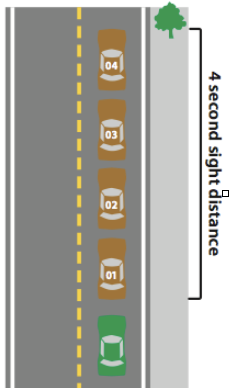Session 24 – How Well Can You See
HOW WELL CAN YOU SEE
If something is in your path and you need to stop, you need to see it in time to be able to stop. It takes much longer and farther to stop than many people think. If you have good tires and brakes, and the road is dry:
- at 50 mph, it can take about 400 feet to react to something you see and to bring your vehicle to a stop. That is about the length of a city block.
- at 30 mph, it can take about 200 feet to stop. That is almost half a city block in length.
If you cannot see 400 feet ahead, it means you may not be driving safely at 50 mph. If you cannot see 200 feet ahead, you may not be driving safely at 30 mph. By the time you see an object in your path, it may be too late to stop without hitting it.
Here are some things that limit how well you can see and tips you can follow to be a safer driver.
Darkness: It is harder to see at night. You must be closer to an object to see it at night than during the day. You must be able to stop within the distance you can see ahead with your headlights.
Your headlights will let you see about 400 feet ahead. You should drive at a speed that allows you to stop within this distance.
Rain, fog, or snow: In very heavy rain, a snowstorm or thick fog, you may not be able to see much more than 200 feet ahead. When you cannot see any farther than that, you cannot safely drive faster than 30 mph. In a very heavy downpour, you may not be able to see well enough to drive. If this happens, pull off the road in a safe place and wait until the rain lets up.
Hills and curves: You may not know what is on the other side of a hill or just around a curve, even if you have driven the road many times. If a vehicle is stalled on the road just over a hill or around a curve, you must be able to stop. Whenever you come to a hill or curve where you cannot see over or around it, adjust your speed so you can stop if necessary.
Parked vehicles: Vehicles parked along the side of the road may block your view. People may be ready to get out of a vehicle or walk out from between parked vehicles. Give parked vehicles as much room as you can.
Animals: Many deer are hit by cars, especially in October and November. Be especially cautious when you see “Deer Crossing” signs, especially during the dusk to dawn hours when deer are most active. If you see a deer, reduce speed and sound the horn. Look for other deer following the one you see.
Sight-distance rule: Drive at a speed where you can always safely stop. To tell if you are driving too fast for conditions, use the “Four Second Sight Distance Rule.”

Pick out a stationary object as far ahead as you can clearly see (e.g. a sign or a tree). Start counting “one-thousand-one, one- thousand-two, one-thousand-three, one-thousand-four.” If you reach the object before you finish saying “one-thousand-four,” you need to slow down because you are going too fast for your sight distance. You must not drive so fast that you cannot stop in your sight distance. If you do, you are not driving safely and could injure or kill yourself or others.
You should also use the “Four Second Sight Distance Rule” at night to make sure you are not “over-driving” your headlights.
Speed limits: You must comply with speed limits. They are based on the design of the road, and the type of vehicles that use them. They take into account things you cannot see, such as side roads and driveways where vehicles may suddenly pull out, and the amount of traffic that uses the road.
Remember, speed limits are posted for ideal conditions. If the road is wet or icy, if you cannot see well, or if traffic is heavy, you must slow down. Even if you are driving under the posted speed limit, you can get a ticket for traveling too fast under these conditions.
